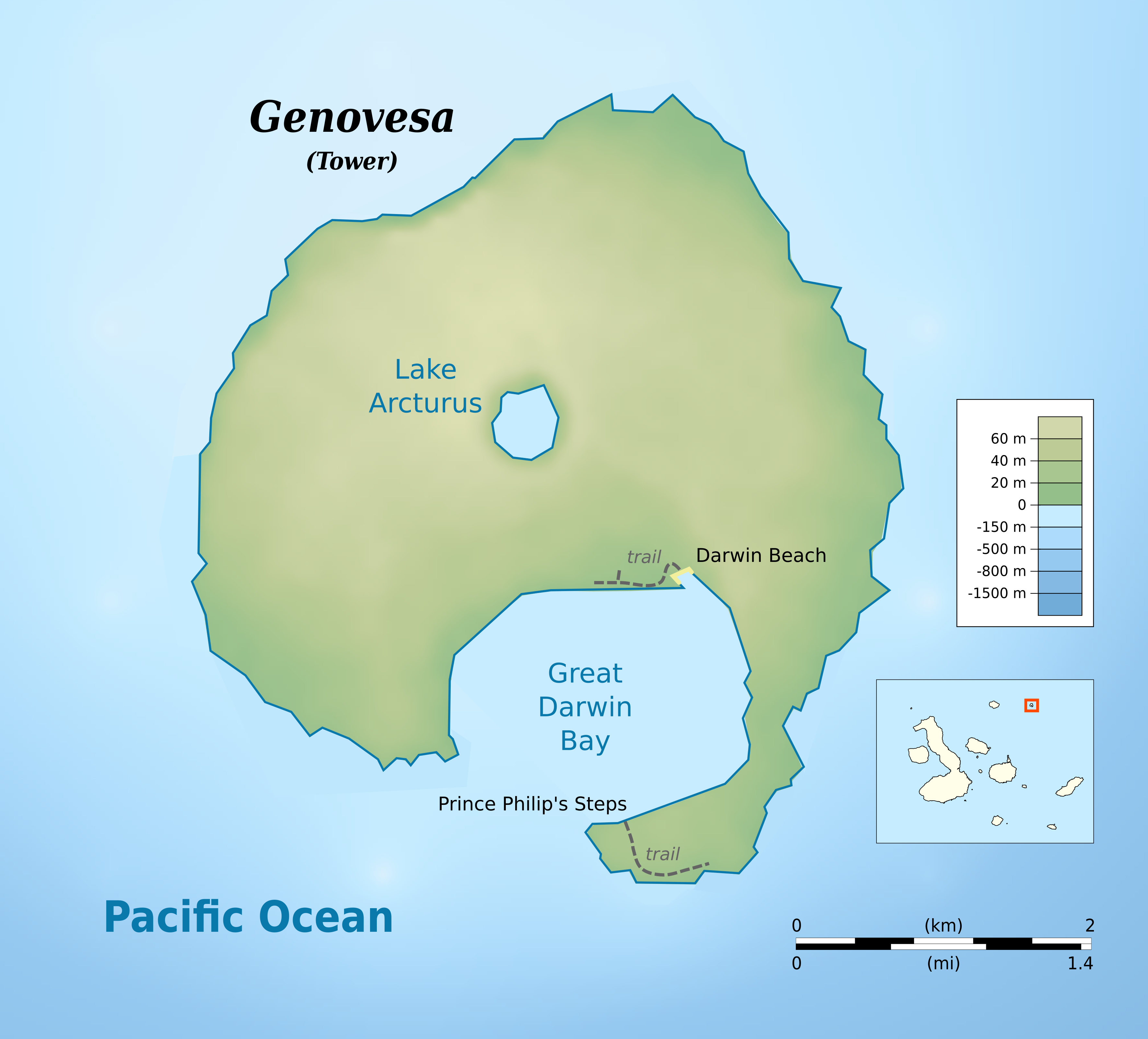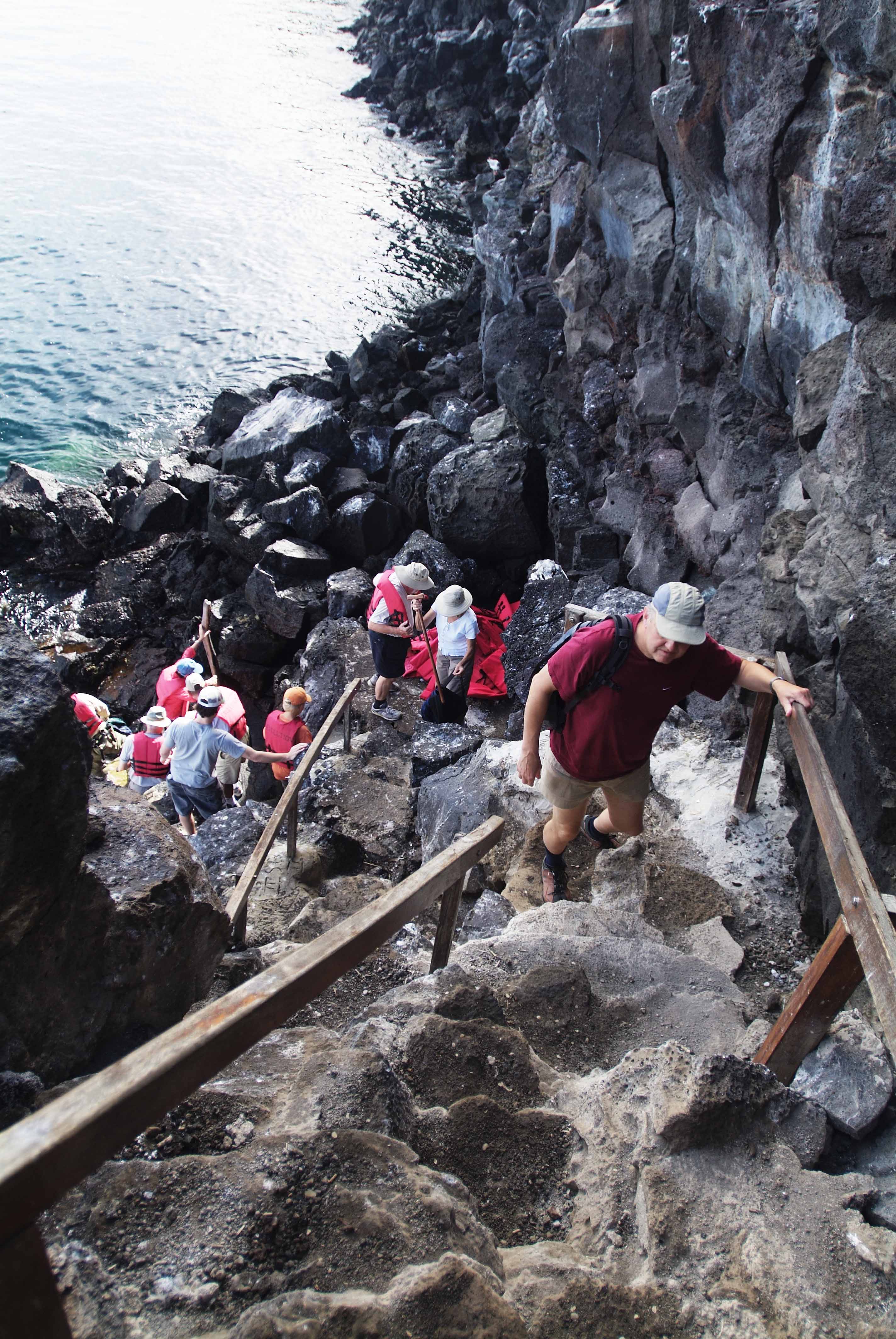Genovesa Island on:
[Wikipedia]
[Google]
[Amazon]
Genovesa Island ( The official Spanish name "Genovesa" is from the Italian city of Genoa, in honor of Christopher Columbus. The English name "Tower" is presumably a corruption of "Downes". The island's position was reported by John Downes of the USS ''Essex'' in 1813, during the
The official Spanish name "Genovesa" is from the Italian city of Genoa, in honor of Christopher Columbus. The English name "Tower" is presumably a corruption of "Downes". The island's position was reported by John Downes of the USS ''Essex'' in 1813, during the
Las Encantadas: Human and Cartographic History of the Galápagos Islands
', 2018, John Woram
Part III: Island and Other Place Names(Dowers)archive, 2016-12-20
:

Images from Genovesa
{{Galápagos Islands Islands of the Galápagos Islands Seabird colonies Shield volcanoes of Ecuador Calderas of the Galápagos Islands Volcanic crater lakes Polygenetic shield volcanoes
Spanish
Spanish might refer to:
* Items from or related to Spain:
**Spaniards are a nation and ethnic group indigenous to Spain
**Spanish language, spoken in Spain and many Latin American countries
**Spanish cuisine
Other places
* Spanish, Ontario, Can ...
: ''Isla Genovesa''), referred to in English as Tower Island, is a shield volcano
A shield volcano is a type of volcano named for its low profile, resembling a warrior's shield lying on the ground. It is formed by the eruption of highly fluid (low viscosity) lava, which travels farther and forms thinner flows than the more vi ...
in the Galápagos Islands
The Galápagos Islands ( Spanish: , , ) are an archipelago of volcanic islands. They are distributed on each side of the equator in the Pacific Ocean, surrounding the centre of the Western Hemisphere, and are part of the Republic of Ecuad ...
in the eastern Pacific Ocean
The Pacific Ocean is the largest and deepest of Earth's five oceanic divisions. It extends from the Arctic Ocean in the north to the Southern Ocean (or, depending on definition, to Antarctica) in the south, and is bounded by the conti ...
. The island occupies about , and its maximum elevation is . The horse-shoe shaped island has a volcanic caldera
A caldera ( ) is a large cauldron-like hollow that forms shortly after the emptying of a magma chamber in a volcano eruption. When large volumes of magma are erupted over a short time, structural support for the rock above the magma chamber is ...
whose wall has collapsed, forming the Great Darwin Bay, surrounded by cliffs. Lake Arcturus, filled with salt water
Saline water (more commonly known as salt water) is water that contains a high concentration of dissolved salts (mainly sodium chloride). On the United States Geological Survey (USGS) salinity scale, saline water is saltier than brackish w ...
, lies in the centre, and sediment within this crater lake
Crater Lake ( Klamath: ''Giiwas'') is a volcanic crater lake in south-central Oregon in the western United States. It is the main feature of Crater Lake National Park and is famous for its deep blue color and water clarity. The lake partly fill ...
is less than 6,000 years old. Although no historical eruptions are known from Genovesa, there are very young lava flow
Lava is molten or partially molten rock (magma) that has been expelled from the interior of a terrestrial planet (such as Earth) or a moon onto its surface. Lava may be erupted at a volcano or through a fracture in the crust, on land or un ...
s on the flanks of the volcano.
 The official Spanish name "Genovesa" is from the Italian city of Genoa, in honor of Christopher Columbus. The English name "Tower" is presumably a corruption of "Downes". The island's position was reported by John Downes of the USS ''Essex'' in 1813, during the
The official Spanish name "Genovesa" is from the Italian city of Genoa, in honor of Christopher Columbus. The English name "Tower" is presumably a corruption of "Downes". The island's position was reported by John Downes of the USS ''Essex'' in 1813, during the War of 1812
The War of 1812 (18 June 1812 – 17 February 1815) was fought by the United States of America and its indigenous allies against the United Kingdom and its allies in British North America, with limited participation by Spain in Florida. It be ...
, and the name "Dowers's" appeared in 1815, presumably a misspelled reference to Downes. After passing through "Dowers's", "Dowers", and "Tower's", by 1841 it was written as "Tower" in the British Admiralty
The Admiralty was a department of the Government of the United Kingdom responsible for the command of the Royal Navy until 1964, historically under its titular head, the Lord High Admiral – one of the Great Officers of State. For much of i ...
chart.Las Encantadas: Human and Cartographic History of the Galápagos Islands
', 2018, John Woram
Part III: Island and Other Place Names
:
Wildlife
This island is known as Bird Island, because of the large and varied bird colonies which nest here. There are an abundance of frigatebirds and it is among the best place in the archipelago to seered-footed boobies
The red-footed booby (''Sula sula'') is a large seabird of the booby family, Sulidae. Adults always have red feet, but the colour of the plumage varies. They are powerful and agile fliers, but they are clumsy in takeoffs and landings. They are f ...
, Nazca boobies
The Nazca booby (''Sula granti'') is a large seabird of the booby family, Sulidae, native to the eastern Pacific. First described by Walter Rothschild in 1902, it was long considered a subspecies of the masked booby until recognised as distinct g ...
, swallow-tailed gull
The swallow-tailed gull (''Creagrus furcatus'') is an equatorial seabird in the gull family, Laridae. It is the only species in the genus ''Creagrus'', which derives from the Latin ''Creagra'' and the Greek ''kreourgos'' which means butcher, al ...
s, storm petrel
Storm-petrel may refer to one of two bird families, both in the order Procellariiformes, once treated as the same family.
The two families are:
* Northern storm petrels (''Hydrobatidae'') are found in the Northern Hemisphere, although some speci ...
s, tropicbird
Tropicbirds are a family, Phaethontidae, of tropical pelagic seabirds. They are the sole living representatives of the order Phaethontiformes. For many years they were considered part of the Pelecaniformes, but genetics indicates they are most cl ...
s, Darwin's finches
Darwin's finches (also known as the Galápagos finches) are a group of about 18 species of passerine birds. They are well known for their remarkable diversity in beak form and function. They are often classified as the subfamily Geospizinae or ...
, and Galápagos mockingbird
The Galápagos mockingbird (''Mimus parvulus'') is a species of bird in the family Mimidae. It is endemic to the Galápagos Islands, Ecuador.
Systematics
The Galápagos mockingbird is one of four mockingbird species endemic to the Galápagos I ...
s.
Prince Philip's Steps is an extraordinary steep path that leads through a seabird
Seabirds (also known as marine birds) are birds that are adapted to life within the marine environment. While seabirds vary greatly in lifestyle, behaviour and physiology, they often exhibit striking convergent evolution, as the same envir ...
colony full of life, up to cliffs that are high. At the top, the trail continues inland, passing more seabird colonies in a thin palo santo forest. The trail also provides overviews of a rocky plain. Storm petrels here are different from any others in the world because they are active during the day. To avoid predators, they only return to their nest holes at night.
The smallest marine iguana
The marine iguana (''Amblyrhynchus cristatus''), also known as the sea iguana, saltwater iguana, or Galápagos marine iguana, is a species of iguana found only on the Galápagos Islands (Ecuador). Unique among modern lizards, it is a marine rept ...
in the archipelago lives here.

Recreation
In Darwin Bay there is the possibility to either dive along the inner wall or go to the outer wall, which is less protected. Another possibility is to dive from the outside of the volcano through the channel into the caldera.See also
*List of volcanoes in Ecuador
A ''list'' is any set of items in a row. List or lists may also refer to:
People
* List (surname)
Organizations
* List College, an undergraduate division of the Jewish Theological Seminary of America
* SC Germania List, German rugby unio ...
References
*External links
Images from Genovesa
{{Galápagos Islands Islands of the Galápagos Islands Seabird colonies Shield volcanoes of Ecuador Calderas of the Galápagos Islands Volcanic crater lakes Polygenetic shield volcanoes